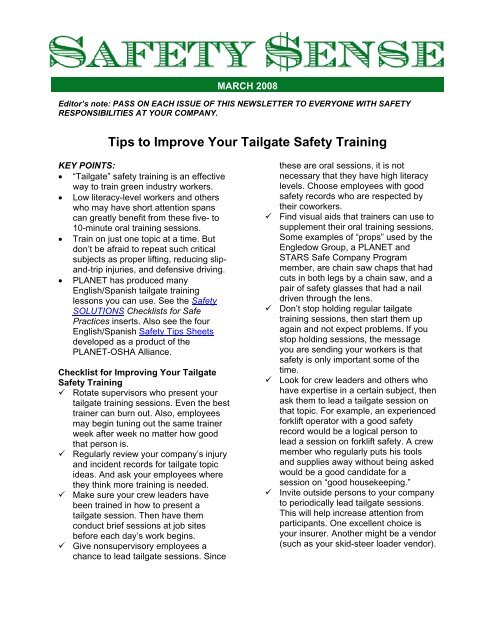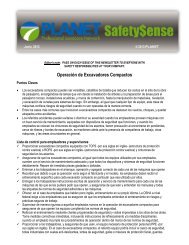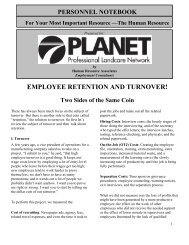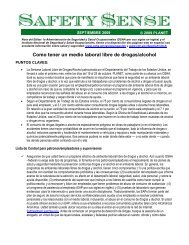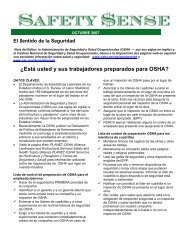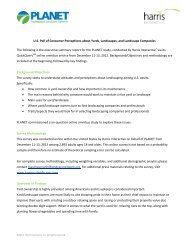Tips to Improve Your Tailgate Safety Training - LandcareNetwork.org
Tips to Improve Your Tailgate Safety Training - LandcareNetwork.org
Tips to Improve Your Tailgate Safety Training - LandcareNetwork.org
Create successful ePaper yourself
Turn your PDF publications into a flip-book with our unique Google optimized e-Paper software.
MARCH 2008<br />
Edi<strong>to</strong>r’s note: PASS ON EACH ISSUE OF THIS NEWSLETTER TO EVERYONE WITH SAFETY<br />
RESPONSIBILITIES AT YOUR COMPANY.<br />
<strong>Tips</strong> <strong>to</strong> <strong>Improve</strong> <strong>Your</strong> <strong>Tailgate</strong> <strong>Safety</strong> <strong>Training</strong><br />
KEY POINTS:<br />
• “<strong>Tailgate</strong>” safety training is an effective<br />
way <strong>to</strong> train green industry workers.<br />
• Low literacy-level workers and others<br />
who may have short attention spans<br />
can greatly benefit from these five- <strong>to</strong><br />
10-minute oral training sessions.<br />
• Train on just one <strong>to</strong>pic at a time. But<br />
don’t be afraid <strong>to</strong> repeat such critical<br />
subjects as proper lifting, reducing slipand-trip<br />
injuries, and defensive driving.<br />
• PLANET has produced many<br />
English/Spanish tailgate training<br />
lessons you can use. See the <strong>Safety</strong><br />
SOLUTIONS Checklists for Safe<br />
Practices inserts. Also see the four<br />
English/Spanish <strong>Safety</strong> <strong>Tips</strong> Sheets<br />
developed as a product of the<br />
PLANET-OSHA Alliance.<br />
Checklist for Improving <strong>Your</strong> <strong>Tailgate</strong><br />
<strong>Safety</strong> <strong>Training</strong><br />
Rotate supervisors who present your<br />
tailgate training sessions. Even the best<br />
trainer can burn out. Also, employees<br />
may begin tuning out the same trainer<br />
week after week no matter how good<br />
that person is.<br />
Regularly review your company’s injury<br />
and incident records for tailgate <strong>to</strong>pic<br />
ideas. And ask your employees where<br />
they think more training is needed.<br />
Make sure your crew leaders have<br />
been trained in how <strong>to</strong> present a<br />
tailgate session. Then have them<br />
conduct brief sessions at job sites<br />
before each day’s work begins.<br />
Give nonsupervisory employees a<br />
chance <strong>to</strong> lead tailgate sessions. Since<br />
these are oral sessions, it is not<br />
necessary that they have high literacy<br />
levels. Choose employees with good<br />
safety records who are respected by<br />
their coworkers.<br />
Find visual aids that trainers can use <strong>to</strong><br />
supplement their oral training sessions.<br />
Some examples of “props” used by the<br />
Engledow Group, a PLANET and<br />
STARS Safe Company Program<br />
member, are chain saw chaps that had<br />
cuts in both legs by a chain saw, and a<br />
pair of safety glasses that had a nail<br />
driven through the lens.<br />
Don’t s<strong>to</strong>p holding regular tailgate<br />
training sessions, then start them up<br />
again and not expect problems. If you<br />
s<strong>to</strong>p holding sessions, the message<br />
you are sending your workers is that<br />
safety is only important some of the<br />
time.<br />
Look for crew leaders and others who<br />
have expertise in a certain subject, then<br />
ask them <strong>to</strong> lead a tailgate session on<br />
that <strong>to</strong>pic. For example, an experienced<br />
forklift opera<strong>to</strong>r with a good safety<br />
record would be a logical person <strong>to</strong><br />
lead a session on forklift safety. A crew<br />
member who regularly puts his <strong>to</strong>ols<br />
and supplies away without being asked<br />
would be a good candidate for a<br />
session on “good housekeeping.”<br />
Invite outside persons <strong>to</strong> your company<br />
<strong>to</strong> periodically lead tailgate sessions.<br />
This will help increase attention from<br />
participants. One excellent choice is<br />
your insurer. Another might be a vendor<br />
(such as your skid-steer loader vendor).
Reduce the Risk of Injuries From Zero-Turn Mowers<br />
KEY POINTS:<br />
• Numerous deaths in our industry have resulted from operating zero-turn mowers (or Z<br />
mowers) <strong>to</strong>o fast, <strong>to</strong>o close <strong>to</strong> bodies of water, or on steep slopes.<br />
• Installing a fold-down, rollover protective structure (ROPS) with a seat belt is a good way <strong>to</strong><br />
reduce the risk of Z mower fatalities. It’s important, however, that the ROPS is kept in its<br />
upright position as much as possible and that the seat belt is used when the ROPS is in its<br />
locked, upright position.<br />
• It’s critical <strong>to</strong> train your workers in Z mower safety. See the February 2007 <strong>Safety</strong><br />
SOLUTIONS Checklist for Safe Practices insert for an English/Spanish training lesson you<br />
can use.<br />
Zero-Turn Mower Opera<strong>to</strong>rs’ Dos and Don’ts<br />
DO —<br />
• Watch your speed when operating a Z mower. And be sure <strong>to</strong> slow down when you are<br />
about <strong>to</strong> make a turn.<br />
• Keep a close eye out for such obstacles as rocks, fallen branches, or other debris in the<br />
mowing path. These obstacles could result in your mower tipping over.<br />
• Always wear the seat belt when your Z mower’s rollover protective structure (ROPS) is in<br />
the fully upright position. The ROPS and the seat belt will help prevent you from being<br />
crushed by the mower if it tips over.<br />
DON’T —<br />
• Operate a Z mower on a slope that is greater than 15 degrees. Check with your crew leader<br />
or another supervisor if you are uncertain of the slope.<br />
• Fold down the ROPS on a Z mower unless you need <strong>to</strong> for clearance. If you do fold it down,<br />
return it <strong>to</strong> its fully upright and locked position as soon as possible.<br />
• Operate a Z mower <strong>to</strong>o close <strong>to</strong> river banks, retaining walls, sudden drop-offs, lakes, ponds,<br />
streams, or other bodies of water.<br />
<strong>Safety</strong> Checklist for Zero-Turn Mower Opera<strong>to</strong>rs<br />
Check the condition of the terrain before you begin mowing. Wet or muddy terrain can result<br />
in losing traction and in your mower tipping over.<br />
Always wear safety glasses when operating a Z mower. They will help protect your eyes<br />
from airborne sticks and other debris.<br />
Keep a safe distance away from the mower’s blades.<br />
Do not remove safety devices. Report any<br />
missing or damaged safety guards or shields<br />
<strong>to</strong> your crew leader or another supervisor.<br />
Prepared by Barbara Mulhern for:<br />
Professional Landcare Network<br />
950 Herndon Parkway, Suite 450<br />
Herndon, VA 20170<br />
(800) 395-2522 Fax: (703) 736-9668<br />
Web site: <strong>LandcareNetwork</strong>.<strong>org</strong><br />
The association of members who create<br />
and maintain the QUALITY OF LIFE in<br />
communities across America.<br />
2


